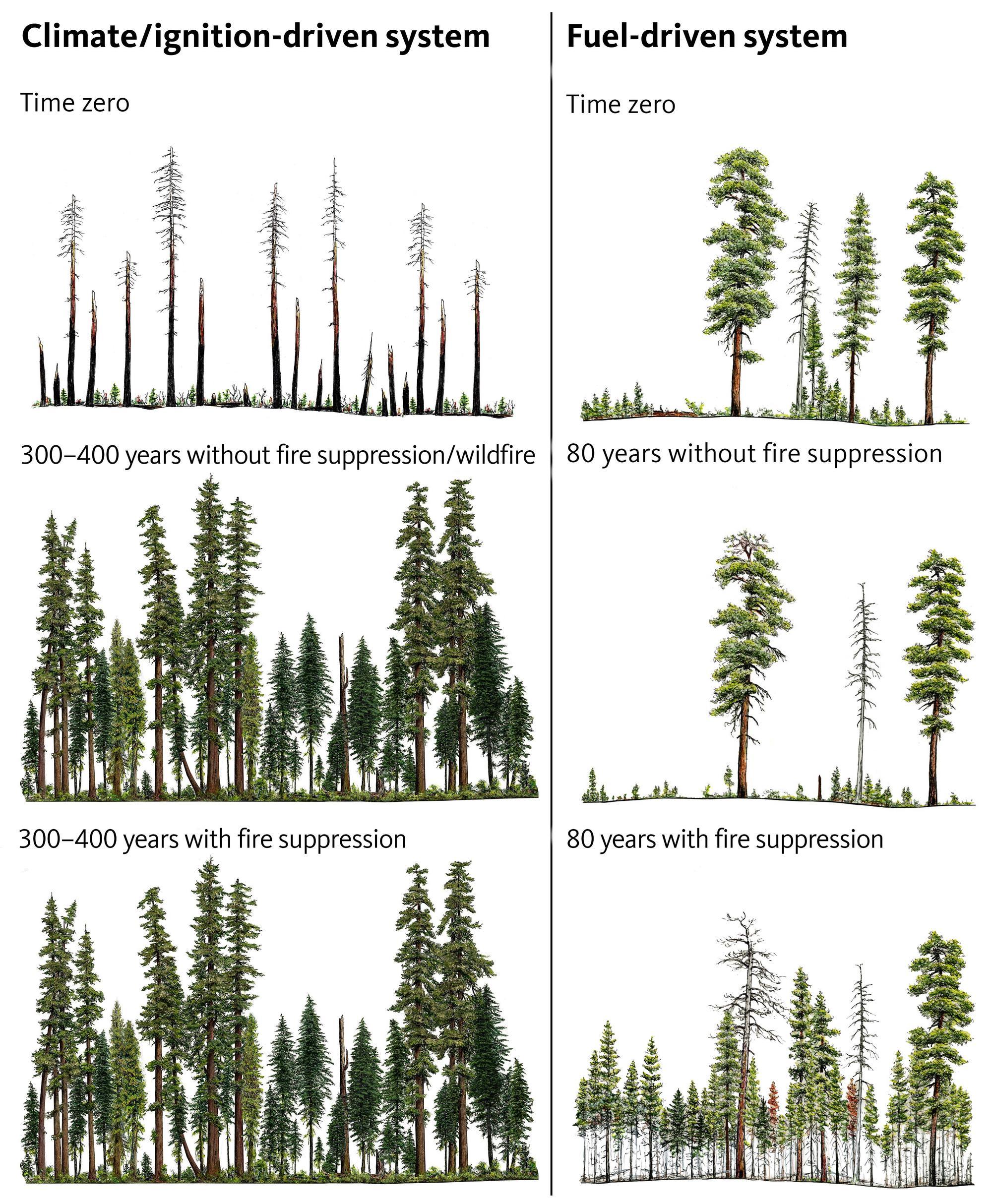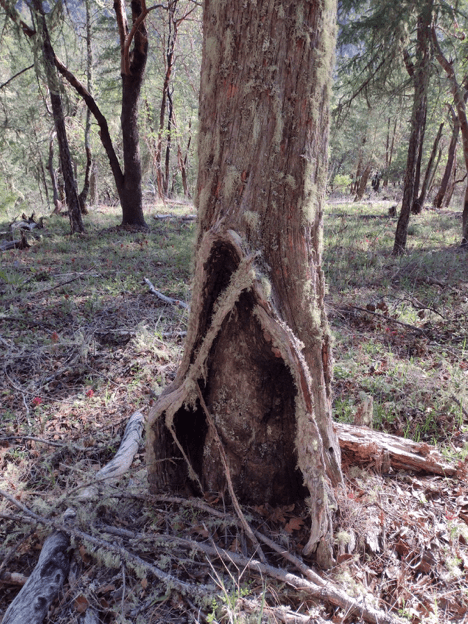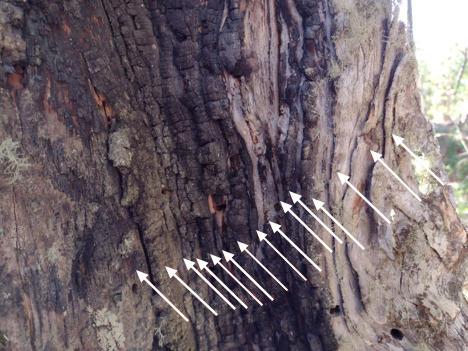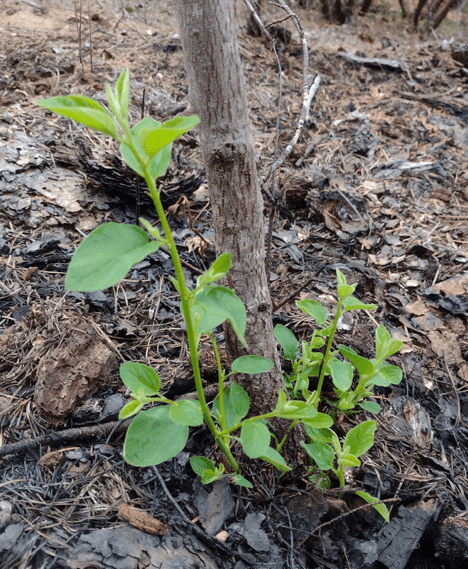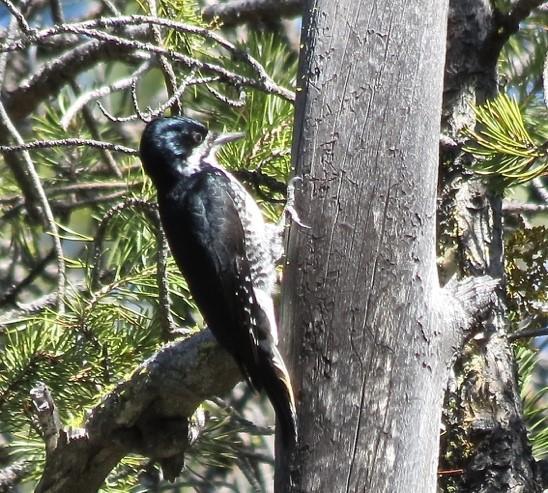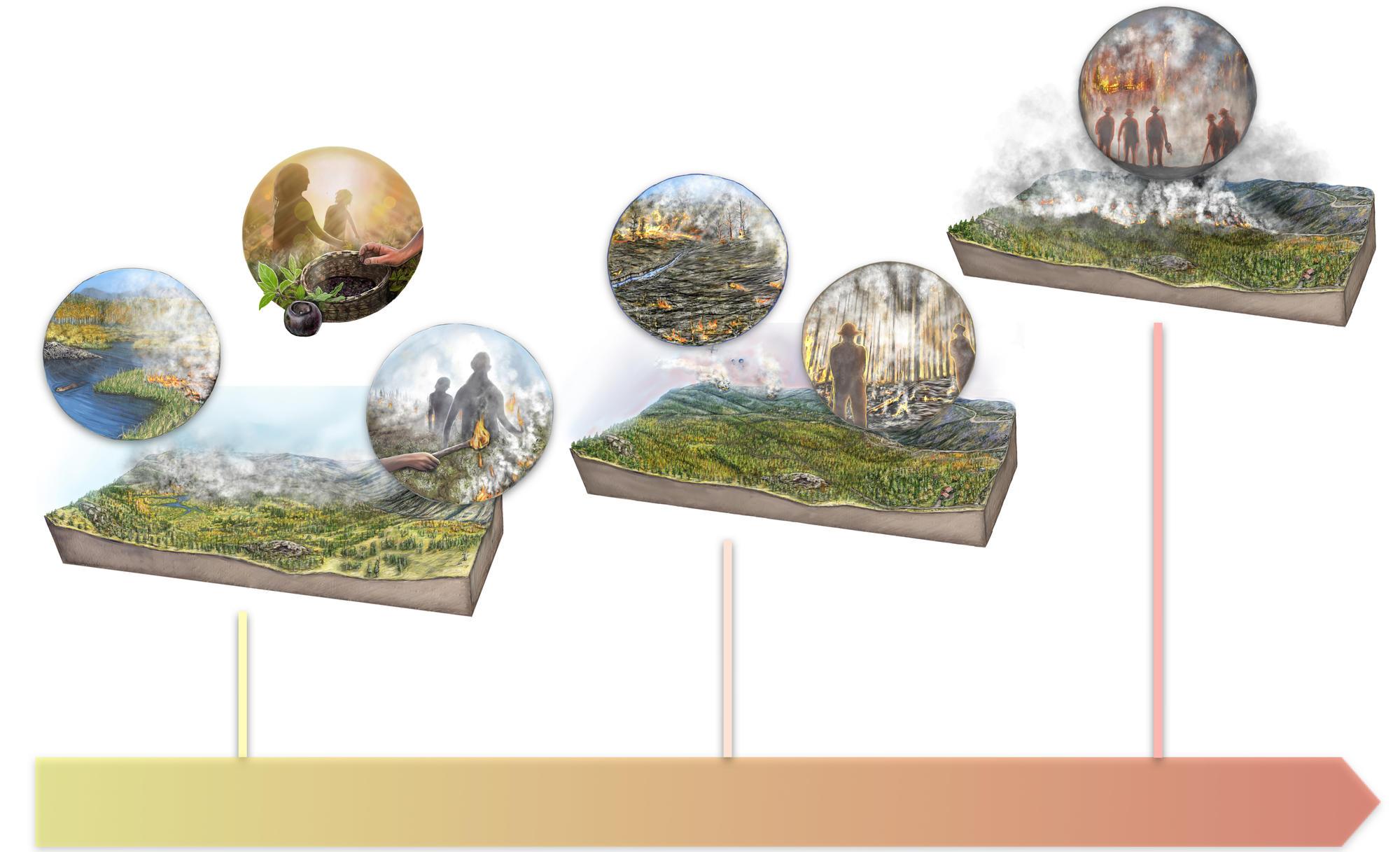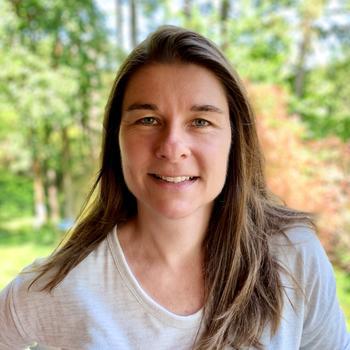Across Oregon, fire shapes ecosystems in diverse ways. Fire’s effects are sometimes obvious, like the forests of blackened trees following a recent high-severity burn. Sometimes, it is harder to tell the ways fire has shaped plant and animal communities in an area. For example, meadows and grasslands often exist because past fires kept trees and shrubs from growing there. Patterns of fire across the landscape over time affect all living beings, and the result is that many species are dependent on fire’s natural role. Some have even developed special adaptations to local fire regimes.
Oregon’s fire regimes
A fire regime is the general pattern in which fire occurs over time in a particular ecosystem. Fire regimes are shaped by the climate, vegetation, and frequency and pattern of ignitions. In turn, they shape plant and animal communities, and ecological processes including water and nutrient cycling. Fire regimes are usually described by how often fires burn and how intense they tend to be. To fully describe a fire regime, other factors can be included like how large fires get, the season in which they usually burn and their pattern on the ground. Oregon has diverse fire regimes across the state.
Forests in the Coast Range, parts of the western Cascades and in some mountainous areas rarely burn. But when they do, large areas are often completely killed by stand-replacing crown fires that engulf entire stands of trees. Most of the time, these forests are too moist to burn, or they lack enough lightning (and/or human ignitions) during their short dry season. For this reason, they are called “climate and ignition limited.” The driving influence of climate on these forests means that prescribed burning is not often used. Vegetation tends to grow so fast that burning to reduce fuels is not effective or practical in many cases. However, prescribed burning remains an important tool for specific habitats such as meadows and coastal headlands, which have a long history of Indigenous burning and remain important for ecological and cultural reasons. (See Prescribed Fire: Why We Burn, EM 9339.)
| Region | Ecosystem | Median fire frequency (years) | Range (years) |
|---|---|---|---|
| Southern Cascades | Ponderosa pine/white fir/red fir | 8 | 5–20 |
| Blue Mountains | Ponderosa pine/Douglas-fir | 10 | 3-22 |
| Klamath-Siskiyou Mountains | Dry mixed evergreen and mixed conifer | 8 | 1–76 |
| Western Oregon interior valleys (Willamette, Umpqua, Rogue) | Oak savannas and grasslands | * | 1–5 |
| North Coast Range and Western Cascades | Moist Douglas-fir/hemlock | * | 200–700 |
| High Desert/Great Basin | Sagebrush steppe | * | 10–100 |
* Fire frequency is difficult to calculate in some ecosystems, either because we lack precise information sources or because fires are so infrequent and variable. Only the range is shown in these cases.
In southwestern and eastern Oregon, forests are typically dry, lightning is frequent and Indigenous fire stewardship was historically common. Before the 20th century and widespread fire suppression, low-severity surface fires were so common that new fires would run into previously burned areas. These ecosystems are therefore called “fuel-limited,” since fire activity is restricted by the lack of contiguous flammable material. This history of frequent fire means that these ecosystems have come to depend on a short interval between burns. In the absence of fire, dry forests lose biological diversity and become more vulnerable to large conflagrations. This is why prescribed burning is an important tool to return fire to its ecological role and manage the risk of uncharacteristically severe fires to communities and natural resources.
This overall distinction between high-severity and low-severity fire regimes is an important generalization, but many factors affect fire behavior to create a more complex pattern of fire severity. (See Fire Behavior, EM 9341.) Particularly in mountainous areas, the intensity of a fire can change greatly when it moves from one slope to another or as the weather changes throughout the day. Temperature, wind and humidity change over the course of the day, so fires are usually less active at night and in the morning than in the afternoon. The result is that the effects of fire are often patchy, leaving some areas where many trees are killed and other areas where fire spread along the ground. This pattern is called a “mosaic,” and it creates habitat for many different animals and plants. Achieving this patchiness can be an important element of a successful ecological burn program.
Plant adaptations to fire
In forests with frequent, low-severity fire regimes, fire prevents trees from growing together to the point of preventing sunlight from reaching the forest floor. As a result, many species of wildflowers and grasses flourish in the light that filters through the open canopy. These species, in turn, provide food for pollinators and herbivores like deer or elk. The whole food chain is dependent on the way fire shapes these forests over time. Similarly, many grasslands need frequent fire to prevent the growth of trees and shrubs that would change the ecosystem and negatively affect many species. In the Willamette Valley, extensive prairies were once maintained by the burning practices of Indigenous people, particularly the Kalapuya. Without fire, sunlight-loving wildflowers and grasses are choked out by dense growth, and many species of birds, insects and mammals can no longer find suitable habitat.
Some species of trees, such as Oregon white oak and ponderosa pine, are particularly dependent on low-severity fires. Oaks need full sunlight to grow, and they can easily survive low-severity fires due to their thick bark. If a more intense fire scorches an oak, buds hidden under the bark can help it regrow a new crown (another species that can do this is the coast redwood). Without fire, conifers often grow taller than nearby oaks, blocking out the sunlight until the oaks die. Ponderosa pines also have thick bark, and they protect their young growth buds in thick sheaths of needles. They also naturally drop their lower branches as they mature, so that fire can’t climb them like a ladder. Their seeds need bare ground cleared by fire to germinate. Without fire, other species like firs and Douglas-fir grow in between pines, weakening them through competition for water and making them more vulnerable to crown fires. Prescribed fire is used in areas of the state where oak and ponderosa pines are common, due to fire’s importance in the ecology of these species.
In forests or shrublands with fire regimes that include high-severity burn patches, species have also found ways to adapt. Some plants have seeds that lie dormant in the ground and germinate after being exposed to heat or smoke (manzanita, buckbrush). Some species release their seeds only when burned in a high-severity fire. Found in southwestern Oregon and California, knobcone pines have cones that stay on the tree and keep their seeds until fire engulfs the whole tree. When this happens, the sap that held the cones closed melts, and the seeds are released to create a new generation of knobcone pines. These special cones are said to be serotinous. Unlike conifers (with the exception of coast redwoods), many hardwood trees (oak, madrone, maple) and shrubs (hazel, willow, salal) grow new shoots from their roots if the top of the plant is killed. In this way, they can grow back quickly from their existing roots.
What about animals?
Animals can usually sense fire and get out of the way. Small animals like rodents and lizards can find refuge in burrows, while larger mammals and birds move away. In all but the most extreme wildfires driven by strong winds, animal casualties are uncommon. Meanwhile, many species benefit from the changes caused by fire.
Some birds like woodpeckers nest in holes in trees killed by fire. For instance, the black-backed woodpecker, found in eastern Oregon’s lodgepole pine forests, is especially associated with dead trees after a fire.
When shrubs grow back, the new shoots are a favorite food for deer and elk, and they provide habitat for shrub-nesting birds like warblers and sparrows. These are a few examples of how animals thrive in the habitats created by fire. While prescribed burns can sometimes disturb animals in the short-term, this impact is short-lived. In fact, some insects and birds are drawn to fires, and deer and elk sometimes return to these areas before the ashes have cooled! In the long-term, negative impacts are typically outweighed by the benefits to these animals’ habitats.
Fire effects on water and soil
Fire affects the cycle of water in surprising ways. Plants use water by taking it up through their roots and releasing it into the atmosphere through their leaves, a process known as evapotranspiration. Because woody plants are thinned by fire, the remaining vegetation uses less water. At the same time, dead leaves and grass catch rain like a sponge before releasing it back into the air. By blocking most precipitation from reaching the soil, this plant barrier can reduce how much water reaches the roots of plants. Fire reduces this barrier to water infiltration. In some cases, the difference is enough that after a burn, seasonal streams might start flowing again even before more rain falls!
Under some conditions, especially if a fire is very intense, the removal of vegetation can mean that water runs off bare slopes faster. This can lead to erosion and sediment running off into rivers. By reducing the likelihood of uncharacteristically high severity fire, prescribed burns also reduce the likelihood of wildfire-induced erosion. Prescribed fires are not typically hot enough to damage the soil, although special care might be needed if there is a large accumulation of fuel. Fires that smolder in thick layers of litter built up over many years can heat the soil enough to kill tree roots and damage soil structure. Appropriate steps may be needed to prepare a site before burning, or cool and moist weather conditions can be chosen to achieve a less intense first burn. (See Planning a Prescribed Burn, EM 9340.)
Changing fire regimes
Fire’s role in Oregon’s ecosystems has been through important changes in the last 160 years. Before colonization, Indigenous people used fire extensively in many ecosystems. Indigenous burning was especially important in maintaining coastal prairies, oak savannas and grasslands of the Willamette, Umpqua and Rogue valleys, as well as meadows and open forests across the state. This practice is referred to today as cultural burning, and it continues, although often on a smaller scale. This is the legacy of genocide and a policy of fire exclusion that attempted to eliminate all fires from the landscape, whether started by Indigenous fire practitioners or by lightning.
This policy was initially highly successful at preventing fires, both in moist forests where fire was already uncommon, and in drier forests where fuel levels were low and fire was easy to suppress. To this day, the majority of fires are extinguished during initial attack. A Bureau of Land Management report found that 97% of fires in Oregon and Washington in 2018 were put out before they reached 100 acres! But the price of this success is that young trees have filled in the spaces that fire historically kept open in dry forests, making them much denser. Meadows have shrunk or disappeared entirely. Forests once made up of large, fire-tolerant species like pine and oak have shifted toward more Douglas-fir, grand fir and white fir. Logging in many areas also removed the large fire-resistant trees, and replaced them with uniform plantations. Due to drought and competition for water, trees are now more stressed and vulnerable to insect and disease outbreaks, and dead vegetation is accumulating. These changes have caused a decline in species that prefer fire-maintained habitats. Without fire, species diversity and ecological resilience in dry forests are diminished.
These changes also mean that fire now burns more intensely in dry forests. An estimated 6% to 9% of the area burned historically in the dry forests of the Pacific Northwest was high-severity, according to a 2019 report in the journal Ecosphere. That number has risen to 36% today. While high-severity burns are not necessarily ecologically damaging (in fact, some species depend on such fires in some areas), this means that fires are creating larger areas where all trees are killed than in the past. Species that rely on old-growth forests are losing habitat, and large legacy trees that lived through many low-severity fires are being lost. In addition, these fires can become difficult or impossible to stop under the extreme weather conditions that are becoming more common due to climate change.
In contrast, fire suppression has had less impact on moister, climate-limited forests, since these tended to burn infrequently already. But concerns are rising that climate change is making fires burn drier and hotter. These fires could put moister forests at greater risk. At lower elevation and on drier sites, trees are dying in greater numbers from prolonged drought. Fire season is getting longer, extreme fire weather is becoming more common and wildfires are harder to control. Because they are so sensitive to climate, it is expected that moist forests will see the greatest relative increase in large fires in the coming years. The role of prescribed burning in alleviating this problem is still unclear given these forests’ history of infrequent burning. On the other hand, there is a strong scientific consensus that fuels reduction and prescribed burning can restore the historic structure and function of dry forests. Even in a warming climate, these actions can help forests adapt, reduce the risk of uncharacteristic high-severity fire, and protect communities and natural resources. Changing fire regimes across Oregon highlight the need to adapt to a future with more fire, including through the use of cultural and prescribed burning.
References
Bureau of Land Management, US Forest Service, Region 6. 2019. “2018 Pacific Northwest wildland fire season: summary of key events and issues.”
Haugo, Ryan D., Bryce S. Kellogg, C. Alina Cansler, Crystal A. Kolden, Kerry B. Kemp, James C. Robertson, Kerry L. Metlen, Nicole M. Vaillant, and Christina M. Restaino. 2019. “The Missing Fire: Quantifying Human Exclusion of Wildfire in Pacific Northwest Forests, USA.” Ecosphere 10(4): e02702.
Acknowledgments
This publication is part of a series developed by the Forestry and Natural Resources Extension Fire Program. The program would like to acknowledge contributions from Ariel Cowan, central regional fire specialist; Emily Jane Davis, Fire Program director and associate professor; Skye Greenler, College of Forestry graduate student; and John Rizza, northeast regional fire specialist.

